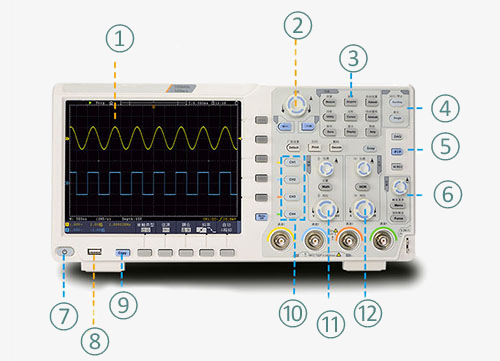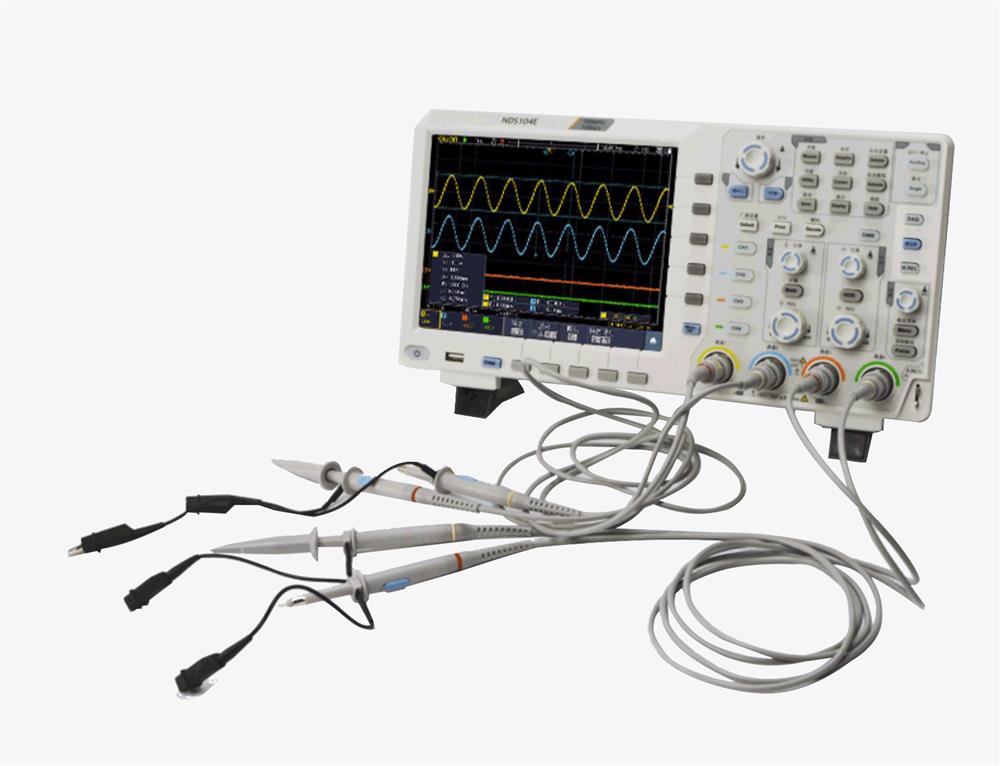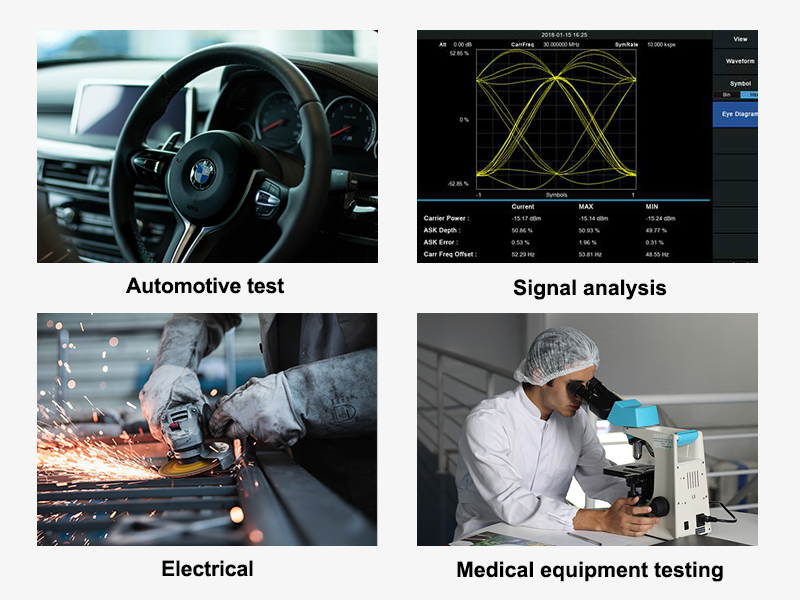SISCO digital oscilloscope with 100 MHz bandwidth, 1 GSa/s sampling rate. The oscilloscope with USB design, multi-function button design with clear button division, which can improve work efficiency, and convenient storage and portable, making work more convenient.

Digital storage oscilloscope interface details
- 8-inch high-resolution LCD screen
- Rubberized knobs
- Common function selection area
- Executive control
- Optional functional area
- Trigger easter egg area
- Switch
- Front USB copy button
- Copy button
- Channel selection button
- Disposal control area
- Horizontal control area

The passive probe as standard
- Better durability
- Four-channel input
- Multi-level grayscale and color temperature display
Application
The main application of a SISCO oscilloscope is used to display the waveforms of signals. It can be used in many fields such as automotive test, signal analysis, electrical, transducer test and measurement, electrical equipment design, medical equipment testing field, etc.

| Model | SISCO-NDS-104E |
| Bandwidth | 100 MHz |
| Channel | 4 Channel |
| Sample rate | 1 GSa/s |
| Acquisition model | Sample, Peak detect |
| Record length | 40M |
| Display | 8 inch LCD |
| Waveform refresh rate | 45000 wfrms/s |
| Input coupling | DC, AC, Ground |
| Probe attenuation | 1X, 10X, 100X, 1000X |
| Input Impedance | 1MΩ ± 2%, in parallel with 15pF ± 5pF |
| Max. input voltage | 400V (DC+AC, PK - PK) |
| Sampling rate range | 2ns/div ~ 1000s/div, step by 1-2-5 |
| Vertical Resolution | 8 bits |
| Sensitivity Resolution | 2mV/div~10V/div |
| Low Frequency(-3db) | ≥5 Hz (at input, AC coupling) |
| Rise time (at input, Typical) | ≤3.5ns |
| Trigger type | Edge |
| Trigger model | Auto, Normal, Single |
| Trigger level range | ±6 div from the screen center |
| Automatic measurement | Vpp, Vavg, Vrms, Frequency, Period, Vmax, Vmin, Vtop, Vbase, Vamp, Overshoot, Preshoot, Rise Time, Fall Time, +Width, -Width, +Duty, -Duty, DelayA→B , DelayA→B |
| Cursor measurement | ΔV, ΔT, ΔT&ΔV between cursors,auto cursor |
| Dimension | 340*177*90mm |
| Weight | 2.6kg |
Accessories
- Power cable
- USB cable
- Probe
- Probe Adjust
- Quick Guide
Q1: Can an oscilloscope measure DC voltage?
A1: DC voltage can be measured using either an oscilloscope or a digital multimeter. Each piece of testing equipment has its advantages and disadvantages.
Q2: What is the maximum frequency for the oscilloscope?
A2: System bandwidth determines an oscilloscope's fundamental ability to measure an analog signal - the maximum frequency range that it can accurately measure. Entry-level scopes will often have a maximum bandwidth of 100 MHz. They can accurately (within 2%) show the amplitudes of sine-wave signals up to 20 MHz.
Q3: What is the record length for an oscilloscope?
A3: The record length, measured in points or samples, divided by the sample rate (in Samples/second) specifies the total time (in seconds) that is acquired. Example: With a record length of 1 M points and a sample rate of 250 MSa/sec, the oscilloscope will capture a signal of 4 msec in length.
Tips: How to calibrate the oscilloscope probe of a digital oscilloscope?
High-performance oscilloscope for the testing high-speed signal is very difficult to ensure that the amplitude and phase frequency response is absolutely flat because of the wide bandwidth. In order to improve the measurement accuracy, the frequency response of the band is required, so that the oscilloscope and the probe test system have a consistent amplitude and frequency response in the whole bandwidth. DC calibration cannot modify frequency response. The probe AC calibration method is to use the network analyzer to test the S parameters of the active probe amplifier, and to correct the frequency response of the probe by testing the loss of each frequency point. The oscilloscope manufacturer will test the S parameters of each probe amplifier and store it in the memory inside the probe. When the user USES the probe, the oscilloscope reads the probe S parameter for AC calibration.
Thank you for buying industrial test and measurement equipment on SISCO.com, all products sold by SISCO and the partner cover a 12 months warranty, effective from the date of receiving the products.
What is covered?
SISCO is responsible for providing free spare parts, and free technical support to assist the customer to repair the defective products until the problem is solved.
What is not covered?
- Product purchased from anyone other than a SISCO store or a SISCO authorized reseller.
- Expendable parts.
- Routine cleaning or normal cosmetic and mechanical wear.
- Damage from misuse, abuse or neglect.
- Damage from use of parts other than SISCO approved.
- Damage from use outside the product’s usage or storage parameters.
- Damage from use of parts not sold by SISCO.
- Damage from modification or incorporation into other products.
- Damage from repair or replacement of warranted parts by a service provider other than a SISCO authorized service provider.
- Damage caused by the application environment not meeting the product usage requirements and the failure to perform preventive maintenance.

